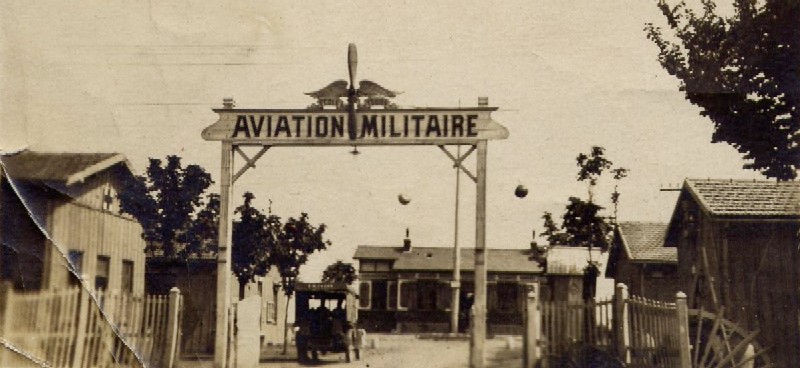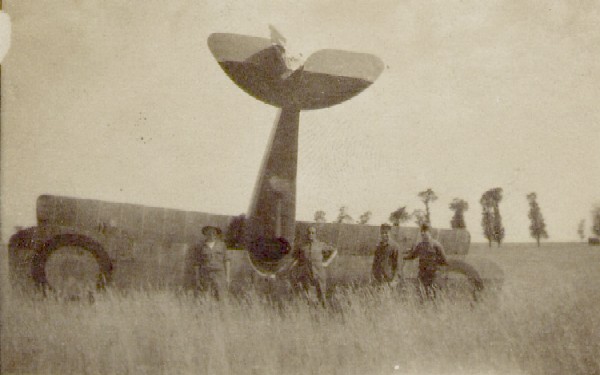|
DONNÉES EN LIGNE SUR CES SEPT
ESCADRONS
ET SUR VINGT DE LEURS MEMBRES
Léon TERRIER & Maurice DORMANN
[dir.], «L’Arrivée des Américains en gare d’…»
[avec un cliché Rameau, le même qui est reproduit sur notre
première carte postale], in L’Abeille d’Étampes et le
Réveil d’Étampes [3e année ; publiée sous
la direction de MM. Léon Terrier et Maurice Dormann] 170 (samedi
29 septembre 1917), p. 1.
Bernard GINESTE [éd.],
«Sept escadrons étatsuniens à Étampes du
19 au 23 septembre 1917 (récit et clichés)», in
Corpus Étampois, http://www.corpsuetampois.com/che-20-19170919etatsuniens.html,
2004-2005 [avec des contributions en 2005 de Denis Decroix (pour la
deuxième photographie, et de Didier Lecq, pour l’identification
des photographies de l’entrée de l’aérodrome de Paraçay-Meslay
et de l’accident d’Issoudun].
THE GREAT WAR SOCIETY
[dir.], «Issoudun Aerodrome Flying School», in World War
I. Trenches on the Web, http://www.worldwar1.com/dbc/issodun.htm,
en ligne en 2004.
Operating the 3rd Aviation Instruction Center required a large
number of organizations. Serving at Issoudun were the following U.S. Aero
Squadrons: 10th, 21st, 26th, 30th, 31st, 32nd, 33rd, 35th, 37th, 43rd,
101st, 149th, 158th, 173rd, 257, 369th, 372nd, 374th, 640th, 641st, 642nd,
644th, 801st, 802nd, and 1104th.
|
30th
Aero Squadron
Sur le 30e escadron
AFHRA
[Air Force Historical Research Agency (Maxwell AFB, Alabama)], «USAF
Air Demonstration Squadron» [30th Aero Squadron], in ID., Research
Division. Organizational History Branch, http://afhra.maxwell.af.mil/wwwroot/rso/squadrons_flights_pages/usafads.html,
2001 (en ligne en 2004).
USAF Air Demonstration
Squadron. Lineage: Organized as 30th Aero Squadron on 13 Jun 1917.
Demobilized on 14 Apr 1919 […]. Assignments : Unkn, 13 Jun-Sep 1917;
Third Aviation Instruction Center, Sep 1917-Jan 1919; unkn, Jan-14 Apr
1919. […] Stations : Camp Kelly (later, Kelly Field), TX, 13 Jun 1917;
Fort Totten, NY, 16-22 Aug 1917; Southampton, England, 15 Sep 1917; Etampes,
France, 19 Sep 1917; Issoudun, France, 23 Sep 1917; Bordeaux, France,
c. 6 Jan-c. 18 Mar 1919; Mitchel Field, NY, c. 5-14 Apr 1919. […] Operations:
Repaired and overhauled aircraft engines in France, Sep 1917-Nov 1918.
[…] Honors: Service Streamers. World War I Theater of Operations. […]
Updated October 12, 2001.
|
John PIKE [éd.], «USAF
Air Demonstration Squadron» [remaniement de la meme page], in GlobalSecurity.org,
http://www.globalsecurity.org/military/agency/usaf/usafads.htm,
2002 (en ligne en 2004).
The US Air
Force Air Demonstration Squadron traces its official lineage to the
30th Aero Squadron which was organized on 13 June 1917 at Camp Kelly (later,
Kelly Field), TX. Assigned, from September 1917-January 1919, to the Third
Aviation Instruction Center, the squadron was tasked with repairing and
overhauling aircraft engines in France; a mission which lasted until November
1918. The squadron was demobilized on 14 April 1919 at Mitchel Field, NY.
|
Sur 6 membres
du 30e escadron
(Robert R. Burdette, Oscar Gorham, Carl V. Brown, Corporal Frank J. Carver, Lewis Philbrick & Clyde Betts)
Janine
M. BORK (Union County GenWeb Coordinator) [éd.], «Robert
R. Burdette: Letter to Mr H. A. Boyle (Camp Kelly, San Antonio,
Texas. June 28, 1917)» [lettre publié dans un journal de
Noth Powder le 7 juillet 1917], in ID., «Union County, Oregon. Genealogy
and History Project», in USGenNet Project [United States
Genealogy Network, Inc.], http://www.usgennet.org/usa/or/county/union1/letters.htm#RRBURDETTE,
1999 (en ligne en 2004).
Camp Kelly, San Antonio, Texas.
June 28, 1917
Mr. H.A. Boyle,
North Powder, Oregon
Friend Harley:
I suspect you will be somewhat surprise
to hear from me, but I will try and write you a few lines anyhow. You
will have to excuse this pencil as my pen is dry.
This is some country down here. It gets
awfully hot here thru the day but it is always cool at night. We are
only 80 miles from the Gulf so we get the ocean breeze every day. It
hasn’t rained for about six weeks. The crops are beginning to suffer
some. I am stationed at Camp Kelly, about 7 miles from San Antonio.
This camp is a new Aviation Field. It has just been started since the
first of the year. The government intends to make this the largest
aviation center in the world. They have about 100 machines here now.
They are building steel hangars for them just as fast as they can. These
machines here are just school machines. They have no war planes here at
present.
It is no uncommon sight to see 12 and more
planes in the air at the same time.
There are between 8,000 and 10,000 men here
at this camp for aviators alone. All the men for the other branches
of the service are stationed on the other side of San Antonio. I was
sure some surprised to hear that Earl McMurren could not pass the examination.
Have any of the other fellows joined the army or navy yet?
Oscar Gorham and myself are still in the
same company. We have been assigned to the 30th Aero Squadron. We will
probably be sent to Panama to train. Do not know for sure.
We do not have so very much to do. We have
to drill 4 hours per day, and nearly all the rest of the time we have
to ourselves.
We have a regular baseball team in our company.
We have cleaned up everything in camp. We have a game scheduled with
the San Antonio State League team for the 4th of July. Have you fellows
been playing any ball?
If any of the fellows are in danger of being
drafted, I would advise them to join right away while they can choose
which ever branch of the service they want. Because when the draft starts
they will be put in the Infantry and the drafted men are sure going to
get the worst end of it all of the time.
We are getting good wages now, $30.00 per
mongth and board and clothes.
I would like to be at home but I have never
regretted joining the army.
I will have to close for this time as it
is drill time. Will write more next time.
Give my regards to all of the fellows.
If you ever have time I would sure like to hear from you.
I am as ever your friend,
ROBERT R. BURDETTE,
Camp Kelly,
San Antonio, Texas
Provisional Aviation School Squadron.
North Powder
News, Saturday
July 7, 1917
|
INTERMENT.NET, «Chattanooga National
Cemetery (Chattanooga, Hamilton County, Tennessee). Surnames Bro»
[page des patronymes commençant par Bro-], in ID., Cemetery Transcription
Library [Browse 3,709,236 cemetery records across 7,882 cemeteries
from around the world] http://www.interment.net/data/us/tn/hamilton/chattanat/index_bro.htm,
en ligne en 2004.
Brown, Carl
V, b. 02/28/1894, d. 08/14/1962, CHAUFF 30TH AERO SQUADRON AIR SERVICE
USA, Plot: PP 608, bur. 08/17/1962, * [* Records with an asterisk at
the end indicates those that have not been verified as accurate by the
U.S. Department of Veterans’ Affairs].
|
DVRBS.COM [The Delaware Valley Rhythm
& Blues Society, Inc., A non-profit Organization dedicated to Classic
Rhytm & Blues Music, Local History, Community Service], «Frank
J. Carver», in ID, Camdem County War Dead Index, http://www.dvrbs.com/WW1-FrankJCarver.htm,
en ligne en 2004.
American Battle
Monuments Commission. World War I Honor Roll. — Frank J. Carver. —
Corporal, U.S. Army. — 30th Aero Squadron. — Entered the Service from:
New Jersey. — Died: October 21, 1918. — Buried at: ?. — CORPORAL FRANK
J. CARVER was born in 1886. He had lived at 67 South 29th Street in Camden
NJ. He enlisted in the Army Aviation Corps at the age of 31 on December
1, 1917. He was sent to Camp McArthur in Waco TX, where he was assigned
to the 30th Aero Squadron on December 20. After training there he was
sent to Camp Greene NC, after which he was again transferred, this time
to Hempstead NY, on Long Island, on August 1, 1918. — Corporal Frank J.
Carver died of pneumonia at Hempstead NY on October 21, 1918. He was survived
by his mother, Mrs. Eleanor Carver.
|
Alice ALLEN & Holly VONDEROHE [éd.],
«The Camas Post, November 16, 1917» [extrait d’un journal
local du Comté de Clarck dans l’état de Washington, USA],
in ID., «THIS WEEK IN CLARK COUNTY», in USGenWeb Project
[United
States Genealogy Network, Inc.], http://www.rootsweb.com/~waclark/ccwweek2.html,
1999 (en ligne en 2004).
The Camas Post,
November 16, 1917:
Personals:
A letter received
recently at the W. W. PHILBRICK home, from their son, Lewis, says that
the latter is now with the 36th aero squadron in France. Further statement
is made that the Camas company of boys in the aero service has been broken
up and assigned to various stations. PHILBRICK and Clyde BETTS are yet together
in the 36th to which they were recently transferred from the 30th squadron.
|
31st
Aero Squadron
Sur
le 31e escadron
Philippe
COLIN, «31st Test and Evaluation Squadron », in ID., The
FB-111A “Switchblade”, http://www.fb-111a.net/31TES.html,
en ligne en 2004.
The 31st Aero squadron of the Army Signal Corps was organized at
Kelly Field, TX on June 26, 1917. This was to be the genesis of a long and
prestigious history. The squadron served in France during World War I and
it was there that the "skull and crossbones" were first placed upon a 31st
Aero Squadron aircraft. The patch was officially approved in 1934 by the
War Department.
|
Sur le
capitaine Spatz (plus tard Spaatz), chef de cette unité
(plus tard Général
et l’un des artisans du débarquement de 1944)
US AIR
FORCE, «General Carl A. Spaatz», in ID., Air Force Link
[the official World Wide Web site of the United States Air Force], http://www.af.mil/bios/bio.asp?bioID=7210,
en ligne en 2004.
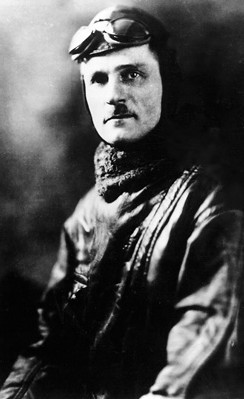 GENERAL CARL A. SPAATZ. — Retired June 30, 1948.
Died July 14, 1974.
GENERAL CARL A. SPAATZ. — Retired June 30, 1948.
Died July 14, 1974.
General Carl A.
Spaatz was the first chief of staff of the U.S. Air Force, Washington,
D.C.
The general was born in 1891, in Boyertown,
Pa. In 1910, he was appointed to the U.S. Military Academy. He graduated
June 12, 1914, and was commissioned a second lieutenant of Infantry.
He served with the 25th United States Infantry at Schofield Barracks, Hawaii,
from Oct. 4, 1914, to Oct. 13, 1915, when he was detailed as a student
in the Aviation School at San Diego, Calif., until May 15, 1916.
In June 1916, General Spaatz was assigned
at Columbus, N.M., and served with the First Aero Squadron under Gen.
John J. Pershing in the Punitive Expedition into Mexico. He was promoted to first lieutenant July 1, 1916, in
May 1917 joined the Third Aero Squadron in San Antonio, Texas, and
in the same month was promoted to captain.
General
Spaatz went to France with the American Expeditionary Forces in command
of the 31st Aero Squadron and, after Nov. 15, 1917, served in the American
Aviation School at Issoundun continuously, except for one month at
the British Front, until Aug. 30, 1918. In this period, he received a
temporary promotion to major.
He joined the Second Pursuit Group in September
1918, as pursuit pilot in the Thirteenth Squadron, and was promoted to
flight leader. He was officially credited with shooting down three German
Fokker planes, and received the Distinguished Service Cross. [...]
|
US AIR FORCE,
«General Carl A. Spaatz» [autre page], in ID., Air Force
Link [the official World Wide Web site of the United States Air Force],
http://www.af.mil/history/person.asp?dec=1940&pid=123006494, en ligne en 2004 (N’est
plus en ligne en août 2004).
General Carl A. Spaatz
Carl Andrew "Tooey" Spaatz was the first
chief of staff of the independent Air Force and a main developer of
tactical air doctrine. During World War II, Spaatz commanded the largest
armada of aircraft and airmen ever assembled under the control of a single
commander. In an historic first, he also commanded the Army plane "Question
Mark" in its refueling endurance flight in California over the Los Angeles
vicinity from Jan. 1 to 7, 1929, keeping the aircraft aloft a total of
nearly 151 hours.
Spaatz was born in June 1891, in Boyertown,
Penn. In his early years, he acquired the nickname "Tooey" which stuck
with him his entire life. In 1910, he was appointed to the U.S. Military
Academy, and commissioned a second lieutenant of Infantry in 1914. He
served with the 25th U.S. Infantry at Schofield Barracks, Hawaii, from
1914 to 1915, when he was detailed as a student in the Aviation School at
San Diego, Calif.
In June 1916, Spaatz was assigned at Columbus,
N. M., and served with the 1st Aero Squadron under Gen. John J. Pershing
in the Punitive Expedition into Mexico. Spaatz went
to France with the American Expeditionary Forces as commander of the
31st Aero Squadron. Later that year he became a member of the American
Aviation School at Issoudun. In 1918 he joined the 2d Pursuit
Group and was promoted to flight leader. On that assignment he was credited
officially with downing three German Fokker aircraft and was awarded
the Distinguished Service Cross. [...]
|
ANONYME,
«General Carl Spaatz», in ALLSTAR Network [Aeronautics
Learning Laboratory for Science, Technology, and Research], http://www.allstar.fiu.edu/aero/spaatz.htm,
en ligne en 2004.
Carl Spaatz was
an army and air force officer. Born on June 28, 1891, in Boyertown, Pennsylvania,
Spaatz (originally Spatz - he added an “a” in 1937) graduated from
West point in 1914 and was commissioned in the infantry. After a year
at Schofield barracks, Hawaii, he entered aviation training in San Diego,
California, becoming one of the army’s first pilots in 1916 and winning
promotion to first lieutenant in June. He advanced to captain in May
1917 and was ordered to France in command of the 31st Aero Squadron. He
organized and directed the aviation training school at Issoudon and by
the end of the war had managed to get just three weeks’ combat duty, during
which he shot down three German aircraft. In June 1918 he was promoted
to temporary major. […]
From Webster’s American Military
Biographies, Merriam Co., 1978. 497p., Carl Spaatz, pp. 404-405.
|
ANONYME, «D-Day Leaders: Spaatz», in MILITARY.COM, Military.Com
remembers D-Day, http://www.military.com/Content/MoreContent1/?file=dday_leaders7,
en ligne en 2004.
Carl Andrew
’Tooey’ Spaatz (his surname was originally Spatz, the extra "a" was
added in 1937) was born in Boyertown, Penn. on June 28, 1891. After
graduating from West Point in 1914, he was commissioned as a second lieutenant
in the infantry and assigned to the Schofield Barracks in Hawaii. He volunteered
for the fledgling Air Corps in 1916 and became one of the first military
aviators in the U.S. Army.
In May 1917 he was promoted to captain
and placed in command of the 31st Aero Squadron in France.
His primary mission was to establish
a curriculum and training plan for the 3rd Aviation Instruction Center
at the aerodrome at Issoudon. By the end of World War I he managed three
weeks of combat flight time, during which he received the Distinguished
Service Cross for shooting down three German aircraft. In June 1918
he was brevetted a major.
|
Roel BOONS & ABOUTTHEWORLDWAR2.TK [De
Tweede Wereldoorlog samengevat], «Spaatz, Andrew Carl», in
Users.Skynet.be, http://users.skynet.be/fa101291/personen/Spaatz.htm,
en ligne en 2004.
Carl Andrew
’Tooey’ Spaatz (his surname was originally Spatz, the extra "a" was
added in 1937) was born in Boyertown, Penn. on June 28, 1891. After
graduating from West Point in 1914, he was commissioned as a second lieutenant
in the infantry and assigned to the Schofield Barracks in Hawaii. He volunteered
for the fledgling Air Corps in 1916 and became one of the first military
aviators in the U.S. Army.
In May 1917 he was promoted to captain and
placed in command of the 31st Aero Squadron in France.
His primary mission was to establish a curriculum
and training plan for the 3rd Aviation Instruction Center at the aerodrome
at Issoudon. By the end of World War I he managed three weeks of combat
flight time, during which he received the Distinguished Service Cross
for shooting down three German aircraft. In June 1918 he was brevetted
a major.
|
Robin SMITH, «Maj
Carl A. Spaatz» [avec des photos dont celle reproduite ci-dessus],
in ID., ASC History Office [Aeronautical Systems Center], http://www.ascho.wpafb.af.mil/birthplace/SPAATZ.HTM,
2002, en ligne en 2004.
Carl
A. Spaatz entered the U.S. Military Academy in 1910. Spaatz was accepted
for aviation training, received his wings in 1916, and saw his first combat
service with Pershing’s Punitive Expedition in Mexico. In 1917, he went
to France in command of the 31st Aero Squadron, where he shot down three
enemy planes and was awarded the Distinguished Flying Cross. Early in 1919,
Spaatz, from his station at Rockwell Field, San Diego, California, flew
an SE-5 British-built fighter in a transcontinental air race, making the
best time in a single seater.
|
Erwin N. THOMPSON,
Defender of the Gate. The Presidio of San Francisco. A History
from 1846 to 1995. Historic Resource Study [645 p.], Denver, National
Park Service, 1997 dont une edition numérique au format pdf,
http://www.nps.gov/prsf/history/hrs/thompson/tt19.pdf,
en ligne en 2004], p., note 11.
Carl
Spaatz added the second "a" to his name in 1937 in a failed effort to have
people call him "spahtz" instead of "spats", a gentleman’s clothing fad at
that time. Spaatz graduated from West Point in 1914 and accepted a commission
in the Infantry. Following a tour in Hawaii he began aviation training at
San Diego in 1915. In World War I he commanded the 31st Aero Squadron in
France where in three weeks of combat he shot down three enemy planes. Promoted
to temporary major in 1918, he was assigned to the Western Department in
1919. [...]
|
US AIR FORCE, «Biographies: Carl Spaatz», in Davis-Monthan
Flight Log, http://www.dm.af.mil/dm_ops_logbook/biographies.html,
en ligne en 2004.
Carl Spaatz
A highly decorated officer, Carl Spaatz
rose to the rank of First Chief of Staff of the newly created U.S. Air
Force in 1947. His career spanned three of the most formative decades
of flight. His awards included the Distinguished Flying Cross, Distinguished
Service Medal, Legion of Merit, Distinguished Flying Corss, Bronze Star
Medal. He received ribbons for three conflicts in which he took place—the
Mexican Interior Campaign, World War I, and World War II. Foreign awards
Spaatz received included the Grand Officer of the French Legion of Honor,
the French Coix de Guerre, Grand Commander of the British Empire, Russian’s
Second Order of Suvorov, and Poland’s Polonla Restituta Commander’s Cross
with Star.
Spaatz was born on June 28, 1891, in
Pennsylvania. He attended the U.S. Military Academy, graduating in
1914. Spaatz was commissioned a 2nd lieutenant with the 25th Infantry
at Schofield Barracks, Hawaii. In October 1915, his career in aviation
began when he was sent to the Aviation School at San Diego, California.
After completing his schooling in 1916, he was assigned to the 1st Aero
Squadron, which was serving with Gen. John J. Pershing’s Punitive Expedition
in Mexico.
In May 1917, Spaatz was assigned to
the 3rd Aero Squadron in San Antonio, Texas, and was soon promoted to
captain. When the United States became involved in World War I, Spaatz
was sent to France with the American Expeditionary Forces in France, serving
with the 31st Aero Squadron. While in Europe, Spaatz served in the American
Aviation School at Issoudun, as well as at the British Front up until
August 30, 1918. The following month, he joined the 13th Squadron of the
2nd Pursuit Group, where he was promoted to flight leader. During this
period he shot down three German Fokker planes, and received the Distinguished
Service Cross.
Following the end of the war, Spaatz
served in California and Texas, becoming the assistant air service officer
for the Western Department beginning in July 1919. Following a promotion
to major, he was placed in command of Kelly Field, Texas, where he served
until February 1921. He then served as Air Officer of the 8th Corps Area
and later as commanding officer of the 1st Pursuit Group at Ellington
Field, Texas, and later at Selfridge Field, Michigan. By June 1925, he served
in the office of the Chief of Air Corps in Washington, D.C. […].
|
Sur un
autre membre du 31e escadron
(Sergent Fuecy Cutlip)
Darilee BEDNAR
[éd.], «SW Washington Servicemen and women World War 1.
Caverley to Cutlip», in ID., Skagit County (Washington)
USGenWeb Project, http://www.rootsweb.com/~waskagit/swww1service4.html,
en ligne en 2004.
In the Service The Great World War Honor Roll Southwest
Washington was published by F. H. Cole Printing Co of Centralia Wash,
No copyright date was found but usually these books were printed about
1921 and in fact this book has a receipt dated 1920. This book is unusually
descriptive and that prose was created by "Mrs. Kina Bower, Historian, who
arranged the information in story form so that it could easily read and
understood." Some of the example biographies were chosen because of her
prose. This book was published after the "Centralia Murder" on Armistice
Day.
|
Sgt. Fuecy Cutlip,
of PeEll
enlisted in the service 4 Jul 1917, at Aberdeen.
He was assigned to the 31st Aero Squadron, and sent to San Antonio TX
for training. Here he was promoted to Sergeant, and sailed for France,
11 Sep 1917. He served in France and England until 18 Mar 1919, when he
sailed for home. He was sent to Camp Mills and received his discharge 11
Apr 1919.
|
32d
Aero Squadron
Sur le 32e escadron
AFHRA
[Air Force Historical Research Agency (Maxwell AFB, Alabama)], «32d Air Refueling Squadron» [32d Aero Squadron],
in ID., Research Division. Organizational History Branch, http://afhra.maxwell.af.mil/wwwroot/rso/squadrons_flights_pages/0032ars.html, 2001 (en ligne en 2004).
32d Air Refueling
Squadron. — Lineage: Organized as 32d
Aero Squadron on 13 Jun 1917. Demobilized on 14 Apr 1919. […]. — Assignments:
Unkn, 13 Jun–Sep 1917; Third Aviation Instruction Center, Sep 1917–Jan
1919; unkn, Jan–14 Apr 1919. […]. — Stations: Camp Kelly, TX, 13 Jun–11
Aug 1917; Etampes, France, 20 Sep 1917; Issoudun, France, 28 Sep 1917;
Bordeau, France, c. 6 Jan–c. 18 Mar 1919; Mitchel Field, NY, c. 5–14
Apr 1919. […]. — Operations : Aircraft repair, 1917–1918. […]. — Honors:
Service Streamers. World War I Theater of Operations. […]
|
John
PIKE [éd.], «32nd Air Refueling Squadron [32nd ARS]» [remaniement de la même
page], in
GlobalSecurity.org,
http://www.globalsecurity.org/military/agency/usaf/32ars.htm, 2003 (en ligne en 2004).
The 32nd Air
Refueling Squadron was originally organized as the 32nd Aero Squadron
on 13 June 1917 at Camp Kelly, TX. It was assigned to the Third Aviation
Instruction Center from September 1917 to January 1919, and provided
aircraft repair, from 1917–1918 and flying trainers in France. It was
demobilized on 14 April 1919 at Mitchel Field, NY.
|
Sur deux membre du 32e escadron dont
son commandant
(First Lieutenant
J. Dickinson Este, chef d’unité; Sergent Elmer
D. Truett)
Ralph COOPER [éd.],
«J. Dickinson Este, 1887-1962», in ID., The Early Birds
of Aviation, Inc. [An organization of pioneers who flew solo before
December 17, 1916], http://www.earlyaviators.com/eeste.htm, en ligne en 2004.
J. Dickinson Este. When World War I is three years old and military aviation
is perking up in the States, Jonathan Dickinson Este, (now Rockwood Lane,
Greenwich, Conn.) already a manufacturer of mechanical devices convinces
the War Department it would make a mistake if his services were not utilized.
He is born in Philadelphia March 12, 1887,
had three years at St. Johns military school and graduates from St. Lukes,
and from Princeton as a C.E., 1909. He had experience in motorcycles,
automobiles and racing plus his manufacturing and begins flying lessons
under Walter E. Johnson at Glendinning’s "Philadelphia School of Aviation"
the summer of 1916. By November 15, 1916 he has his seaplane ceretificate
No. 59 of the Aero Club.
After Phil Roosevelt checks his record
he is accepted for enlistment at Fort Monroe, April 15, 1917, and is ordered
to active duty as Sergent Este, Signal Enlisted Reserve Corp, under well-known
section 55, Act of June 3, 1916, at the Curtiss contract school at Newport
News. By June 5 Victor Carlstrom has given him nearly 15 hours, on JN4s
and in another week passes his RMA test and is recommended for commission.
He then finds himself, July 2, 1917, at
Kelly Field as First Lieutenant, Aviation Section, Signal Officers Reserve
Corps, with "Bob" Olds and Randolph G. Page, Carl Spatz and others present.
In August he is commanding officer of the 32nd Provisional Aero Squadron
and in October he is in France with his squadron.
After losing his bedding roll and narrowly
missing Issoudun he is assigned in Paris as policy and liaison officer.
In March he does reach Issoudun, reports
on various fields, takes the gunnery course at Cazaux, returns to the
III A.I.C. and from there to Romorantin on test flying.
As pilot of the 13th Squadron, 2nd Pursuit
Group, 1st Army, (Spad), he is cited for extraordinary heroism in action
near Chambley on September 13, 1918, destroying one EA and driving another
out of control. A few days later his CO, Charles J. Biddle also recommends
him for a Captaincy which comes through in time.
After Armistice he is relieved to return
to the United States and is honorably discharged......... ..president
of the United States Combustion Corporation.
from CHIRP - APRIL, 1947 - PESCO,
CLEVELAND, OHIO - NUMBER 35
courtesy of Steve Remington - CollectAir
|
We
have just learned that J. Dickinson Este died last September. It is lamentable
that no previous information was received although several inquiries from
members have reached us in the last few months.
From The Early Birds of
Aviation CHIRP
October 1962, Number 69
|
Darilee BEDNAR
[éd.], «SW Washington Servicemen and women World War 1.
Page 14», in ID., Skagit County (Washington)
USGenWeb Project, http://www.rootsweb.com/~waskagit/swww1service14.html, en ligne en 2004.
In the Service The Great World War Honor Roll Southwest
Washington was published by F. H. Cole Printing Co of Centralia Wash,
No copyright date was found but usually these books were printed about
1921 and in fact this book has a receipt dated 1920. This book is unusually
descriptive and that prose was created by "Mrs. Kina Bower, Historian, who
arranged the information in story form so that it could easily read and
understood." Some of the example biographies were chosen because of her
prose. This book was published after the "Centralia Murder" on Armistice
Day.
|
Sgt. Elmer D. Truett, of
Chehalis
enlisted in the service 16 Apr 1917 at Vancouver
WA. He was assigned to the 13th Aero Squadron and sent to the Kelly
Field at San Antonio for training. There he was transferred to the 32nd
Aero Squadron, and he sailed for France 11 Aug 1917 on the British Ship
Baltic. He spent 19 months in the air service and was promoted to Sergeant.
After the excitement was all over, he sailed for home, 1919 Mar and was
sent to Camp Lewis, where he received his discharge 19 Apr 1919.
|
33rd
Aero Squadron
Sur trois membres
du 33e escadron
(Tauf Charneski, Raymond H. Green & le Premier Lieutenant Robert
Haverty, probablement chef de cette unité)
Darilee BEDNAR
[éd.], «SW Washington Servicemen and
women World War 1. Page 4» & «SW Washington Servicemen and
women World War 1. Page 6», in ID., Skagit County (Washington)
USGenWeb Project, http://www.rootsweb.com/~waskagit/swww1service4.html
& http://www.rootsweb.com/~waskagit/swww1service6.html, en ligne en 2004.
In the Service The Great World War Honor Roll Southwest
Washington was published by F. H. Cole Printing Co of Centralia Wash,
No copyright date was found but usually these books were printed about
1921 and in fact this book has a receipt dated 1920. This book is unusually
descriptive and that prose was created by "Mrs. Kina Bower, Historian, who
arranged the information in story form so that it could easily read and
understood." Some of the example biographies were chosen because of her
prose. This book was published after the "Centralia Murder" on Armistice
Day.
|
[p. 4] Tauf Charneski of Chehalis
enlisted in the service 12 Apr 1917, at Vancouver
WA. He was assigned to the 33rd Aero Squadron, and sent to the Kelly
Field TX for training. He was there transferred to the 103rd Aero Squadron.
He was promoted to 1st Class Private and left for France 23 Aug 1917 on
the Baltic. He saw service on all fronts. He was in the battle of Champagne.
Chemin des Dames, Flanders, St. Mihiel, Meuse-Argonne and toul Sector.
He served with the 4th Toul Sector. He served with the 4th and 6th French
armies and was decorated for his daring and gallantry. He received the
Croix-de-Guerre. and was cited two or three times. He stuck with it until
the fighting was over, and remained in France until 19 Feb 1919 when he
sailed home on the Frederick. He was sent to Camp Lewis, and received his
discharge 22 May 1919. |
[p. 6] Raymond H. Green, of Centralia
enlisted in the service 10 Apr 1917 at Centralia.
He was assigned to the Air Service and sent to Vancouver Barracks. He
was transferred from there to Kelly Field, San Antonio TX. He sailed overseas
23 Aug 1917 on the Troopship Baltic, from New York. Here he was put
in the 33rd Aero Squadron. He served in France until 17 Mar 1919, when
he sailed for America on the Arizonian. He was sent to Camp Lewis upon
his arrival and there received his discharge, 18 Apr 1919.
|
ANONYME («Charles»), «The British, French
and U.S. Services: 1st Lieutenant Robert Haverty», in The
Aero Conservancy to preserve early Areonautica. A Virtual Museum of
Early Artifacts, http://www.aeroconservancy.com/allies.htm,
2003 (en ligne en 2004).

 1st Lieutenant Robert Haverty
1st Lieutenant Robert Haverty
This is a French Brevet certificate named
to a 1st Lieutenant Robert Haverty awarding him his wings dated July
1, 1918. Top right is the front page of the 18 November 1930 Memphis
Evening Appeal which reports the formation by Major Robert Haverty of
the 105th Observation Squadron, “a Tennessee State unit,” and goes on
to say that “Maj. Haverty was attached to the 33rd Aero Squadron at Issoudon
France. At the time of his enlistment, he knew that his eyesight was
not up to wartime regulations so he memorized the vision charts so he
could fight in the air.” Tennessee State Library & Archives
records show that Haverty was born June 17, 1889 in Atlanta, Georgia,
lived in Memphis, Tennessee, enlisting July 17, 1917 at Chicago, "School
of Military Aeronautics Austin Texas to October 18, 1917; Cadet #14 to
Dec 14, 1917; Beaumont Det Flying Cadets #1 to discharge. Grade: Pvt 1
cl July 17, 1917. Hon Disch: June 13, 1918 to Accept Commission. ..Called
into Active Service as: 1st Lt AS June 14, 1918 from ERC. Org & Assgn:
33 Aero Sq to ___; ASA Inassigned to Disch. Principal Stations:
AEF; Garden City N.Y. OS: Nov 14, 1917 to march 6, 1919. Hon Disch:
March 8, 1919.
One source reports that the 33rd Aero Squadron
"arrived as a unit at Issoudon during the late fall
of 1917, assigned to Field #6 or 7 as Cadre and helped to build the barracks
and hangars in one of the worst winter’s on record. Their job was repair
of aircraft (minor), teaching, feeding and housing the students assigned
to them. They left France in about May or April 1919."
|
BONHAMS & BUTTERFIELDS [site de vente],
«Arms Sale 7338a, Aviation Memorabilia», in Bonhams &
Butterfields - Areas of
Collecting - Arms & Armor [catalogue de vente], http://www.butterfields.com/areas/arms/7338A/detail/7338a-1129.htm,
en ligne en 2004.
Framed French Aviator
Certificate Belonging to U.S. Pilot Robert Haverty of the U.S. 33rd
Aero Squadron. — Framed 8 1/2 inch X 12 1/4 inch French award certificate
to American aviator Robert Haverty. Text reads: République Francaise
/ Ministère De La Guerre / Aéronautique Militaire / Brevet
D’Aviateur Militaire / Le Ministere de la Guerre. / Vu l’Instruction
en date du 20 Mai 1914 sur la délivrance du Brevet relatif à
la conduite des candidats au dit Brevet, décerne à la
date du 1er Juillet 1918 à Mr Haverty, Robert, 1st Lieutenant,
le Brevet d’Aviateur Militaire. Fait à Paris, le 19__ / No.
1 of 435. Sold together with news clipping dated 1930 concerning his command
of 15 lieutenants, all named to duty in 105th Observation Squadron. — Condition: Certificate with
age discoloration and minor stains at bottom. Frame with minor scuffs. — Estimates: 300 / 500. — Lot no. 1129. — Sale no. 7338A
|
35th
Aero Squadron
Sur le 35e escadron
AFHRA
[Air Force Historical Research Agency (Maxwell AFB, Alabama)], «35th
Fighter Squadron» [35th Aero Squadron], in ID., Research Division.
Organizational History Branch, http://afhra.maxwell.af.mil/wwwroot/rso/squadrons_flights_pages/0035fs.html,
2001 (en ligne en 2004).
35th Fighter
Squadron. — Lineage: Organized as 35th Aero Squadron on 12 Jun 1917.
Demobilized on 19 Mar 1919. […]. — Assignments: Unkn, 12 Jun–Nov
1917; Third Aviation Instruction Center, Nov 1917–Jan 1919; unkn, Jan–19
Mar 1919. […]. — Stations: Camp Kelly, TX, 12 Jun–11 Aug 1917; Etampes,
France, 20 Sep 1917; Paris, France, 23 Sep 1917; Issoudun, France, Nov
1917; Clisson, France, 4 Jan 1919; St. Nazaire, France, 9–20 Feb 1919;
Garden City, NY, 9–19 Mar 1919. […]. — Operations: Assembled and maintained
aircraft and constructed facilities, 1917–1918. […]. — Honors: Service
Streamers. World War I Theater of Operations. […].
|
347thAMS.COM (347th Avionics Maintenance
Squadron), «35th Fighter Squadron» [page entièrement reprise
de l’AFHRA], http://347thams.com/35th.htm,
2004.
John PIKE, «35th Fighter Squadron
[35th FS] "Panton"» [remaniement de la même page], in GlobalSecurity.org,
http://www.globalsecurity.org/military/agency/usaf/35fs.htm,
2003 (en ligne en 2004).
The 35th Fighter
Squadron was originally organized as the 35th Aero Squadron on 12 June
1917 at Camp Kelly, TX. from November 1917 to January 1919, it was assigned
to the Third Aviation Instruction Center and tasked with assembling
and maintaining aircraft as well as constructing facilities in France.
It was demobilized on 19 March 1919 in Garden City, NY.
|
KUNSAN AIRBASE [USA], «Heraldry and
Notes on Selected Squadrons. 35th Aerosquadron; 36th Aerosquadron; 80th
Pursuit Squadron », in ID., How it was. 8th Fighter Wing History
(1932-1945), http://kalaniosullivan.com/KunsanAB/8thFW/Howitwasb1a1.html#HERALDRY,
en ligne en 2004.
35th Aero
Squadron: The Army organized the 35th Aero Squadron at Camp Kelly, Texas
on 12 June, 1917. On September 20, 1917 the 35th Aero Squadron arrived at
Etampes, France. within three days it would move to Paris and two months
later to Issoudun. During WWI, the 35th did not fly any aircraft. Instead,
it served as a maintenance unit of the Third Aviation Instruction Center
in France. According to the AFHRA: 35th Fighter Squadron, it "Assembled and
maintained aircraft and constructed facilities, 1917–1918." On March 9, 1919,
the squadron returned to the U.S. from France. Then days later it was demobilized.
On March 24, 1923, the Army reconstituted the 35th Aero Squadron on the inactive
list, making it available for later activation. On June 25, 1932, the 35th
joined the 8th Pursuit Group.
|
Sur un membre
du 35e escadron
(Broderick T. Ortega)
INTERMENT.NET, «San Francisco National Cemetery
(San Francisco, San Francisco County, California). Surnames Ok-Pai» [page
des patronymes de Ok- à Pai-], in ID., Cemetery Transcription Library
[Browse 3,709,236 cemetery records across 7,882 cemeteries from around
the world],
http://www.interment.net/data/us/ca/sanfran/sfnat/san_fran_okpai.htm, en ligne en 2004.
San Francisco National Cemetery. — San Francisco, San Francisco
County, California [...]. — Ortega, Broderick T, d. 01/22/1940,
PVT 1/C 35TH AERO SQUADRON AIR SVC, Plot: E-EAS708, bur. 11/26/1940,
* [* Records with an asterisk at
the end indicates those that have not been verified as accurate by the
U.S. Department of Veterans’ Affairs].
|
36th
Aero Squadron
Sur le 36e escadron
AFHRA [Air Force Historical Research Agency (Maxwell AFB, Alabama)],
«USAF Air Demonstration Squadron» [30th Aero Squadron],
in ID., Research Division. Organizational History Branch,
http://www.au.af.mil/au/afhra/wwwroot/rso/squadrons_flights_pages/0036fs.html, 2001 (en ligne en 2004).
36th Fighter Squadron. — Lineage: Organized as 36th Aero Squadron on 12 Jun 1917. Demobilized
on 7 Apr 1919. […]. — Assignments: Unkn, 12 Jun–Sep 1917; Third Aviation
Instructor Center, Sep 1917; French Aerial Gunnery School, Feb 1918;
American Aerial Gunnery School, Nov 1918–Feb 1919; unkn, Feb–7 Apr 1919.[…].
— Stations: Camp Kelly, TX, 12 Jun–11 Aug 1917, Etampes, France, 19 Sep
1917; Issoudun, France, 24 Sep 1917; Cazaux, France, 21 Feb 1918; St Jean–de–Monts,
France, 5 Nov 1918; St Nazaire, France, 16 Feb–14 Mar 1919; Garden City,
NY, 25 Mar–7 Apr 1919. […]. — Operations: Constructed facilities and assembled
and maintained aircraft, 1917–1919. […]. — Honors: Service Streamers.
World War I Theater of Operations.
|
347thAMS.COM
(347th Avionics Maintenance Squadron), «36th Fighter Squadron» [page entièrement reprise
de l’AFHRA], http://347thams.com/36th.htm,
2004.
ANONYME [«Swissy»], «8th Fighter Group
History», in ID., Web-Birds.Com, http://www.web-birds.com/5th/8/8th.htm,
en ligne en 2004.
The 33rd,
35th and 36th Aero Squadrons were activated in 1917 at Camp Kelly,
Texas. During WW 1 they were stationed in several locations in France
where they constructed facilities, maintained Aircraft and functioned
as flying training units.
|
Détails sur le 36e escadron
en 1917 et sur son chef d’unité,
le First Lieutenant
Quentin Roosevelt, fils du Président Roosevelt
KUNSAN AIRBASE [USA], «Heraldry and Notes on Selected Squadrons.
35th Aerosquadron; 36th Aerosquadron; 80th Pursuit Squadron»,
in ID., How it was. 8th Fighter Wing History (1932-1945),
http://kalaniosullivan.com/KunsanAB/8thFW/Howitwasb1a1.html,
en ligne en 2004.
36th Aero Squadron: The following
is excerpted from the 36th Fighter Squadron History first assembled
by TSgt John Sullivan, 51st TFW Historian. "The 36th Aero Squadron was
formed at Kelly Field, Texas on 12 June 1917 by a group of aviation pioneers
who desired to go to Europe and prove the value of air power in World
War I. By August, they had relocated to New York and continued their training
and other preparation for their overseas assignment. En route, they drilled
and paraded at Texarkana, Arkansas; Chattanooga, Tennessee; and Hagerstown
Maryland.
By the light of a full moon on 23 August
1917, the 36th sailed for Europe, specifically Liverpool, England aboard
the S.S. Baltic. Additional ships in the convoy were met at Halifax,
Nova Scotia. The voyage would not be completely without incident. While
rounding the coast of Ireland, a large explosion was felt aboard the
Baltic and immediate fears were that a German "U-Boat" was in the area.
A diary read:
…It was just after supper, quite
a few of us were up on the deck while others were below playing cards
or reading. When a terrific crash was heard, followed by five blasts
of the ships whistle which meant – to the boats! This was followed by a
hastened but orderly movement to the lifeboats. An accompanying destroyer
steamed over to the position of the alleged submarine and dropped depth
charges. Further examination of the Baltic revealed only minor damage and
the ship proceeded on to Liverpool where we were discharged…
The convoy continued into Southampton,
where the 36th set up a temporary rest headquarters. While there, the
fifty flyers assigned to the unit spent two days TDY, or as they called
it the, detached duty, with the Royal Flying Corps for training. Other
personnel continued preparations for the move to France. By 18 September
1917 the 36th had reached Le Havre, France. German Prisoners of War at
Le Havre refused to believe that the men of the 36th were part of the US
Army. They had been certain that German submarines were blockading all attempts
to move US troops overseas.
Two days later
the men of the 36th received a royal welcome at the town of Etamps,
France. Civic leaders and military officials conducted a welcoming ceremony.
Each man of the 36th received a ticket, which was good for one free drink,
which could be used at any café in town. The men soon found out
that they could present the ticket, imbibe one drink, and then ask for
the ticket back to keep as a souvenir. This process was repeated throughout
the night, and as the town had about 74 cafes, the squadron was temporarily
immobilized.
The 36th Squadron was dispersed to
various French airplane factories and motor schools for continued training:
One detachment went to Paris, another to Lyon, while the Commander and
his headquarters element remained at Issoudum, France. Commanding the
36th at this time was 1Lt Quentin Roosevelt. In a letter to his father,
the former President of the United States, Theodore Roosevelt, the young
Lieutenant stated:
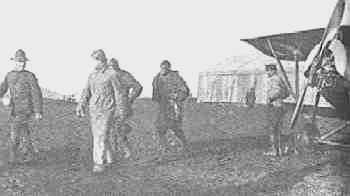 Father, I command a wilder bunch
of roughnecks that your roughriders ever dared to be!
Father, I command a wilder bunch
of roughnecks that your roughriders ever dared to be!
And rough they were. Food was scarce at Issoudun. Often, a meal consisted of three pieces of hard tack,
a cup of coffee, and a spoonful of beans. The coffee was especially good.
However, it was flavored with a distinct wine taste, caused in no small
part by the fact that old wine barrels were considered good water carriers
by 36th personnel. In addition, the men enjoyed the fruits of the surrounding
orchards.
Being able to survive with limited
rations was thing, however, when General John J. Pershing inspected
their unit in late October 1917, the men of the 36th let him know in
no uncertain terms that they would like their pay. It had been more that
three months since their last payday. Two days later, a paymaster arrived
at 10L00 in the evening and help pay call.
Through 1918 the 36th was assigned
to various aerial gunnery schools, and other training areas. Men were
often sent to other units for combat duty or other duties, as required.
The 36th did not get into combat as a unit during the war. Barracks were
constructed entirely through self-help, at La Corneau, France, and hydroplanes
were repaired at that facility, along with an occasional Nieuport. A gunnery
school was also established at St. Jean de Monts, France.
After World War I, the 36th returned
to the United States aboard the SS Mancuria and on 7 April 1919 were
demobilized at Garden City, New Jersey.
|
ANCESTRY.COM, «Quentin
Roosevelt», in ID., Find a grave, http://www.findagrave.com/cgi-bin/fg.cgi?page=gr&GRid=2686&pt=Quentin%20Roosevelt,
1999 (en ligne en 2004).
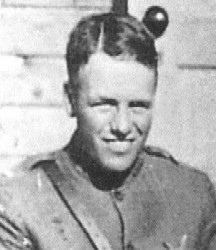
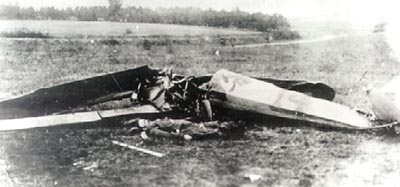 United
States Army Officer. Youngest son of 26th United States President Theodore
Roosevelt. A Lieutenant in the United States Army Air Corps during World
War I, he was killed when his Nieuport 28 aircraft was shot down behind
German lines on July 14, 1918. German soldiers placed a crude cross over
his grave, near the rural French village of Chamery, near Reims. The grave
subsequently underwent some revisions and was treated as a pilgrimage site
by admiring US and French citizens. On July 12, 1944, Quentin’s oldest
brother, Brigadier General Theodore Roosevelt, Jr., died of a heart attack
in Normandy following the invasion of France. After the war, the two brothers
were buried side by side at the US Military Cemetery, Colville-sur-Mer,
Omaha Beach, Normandy, France. The original cross placed on Quentin’s grave
is now on display at the United States Air Force Museum at Wright-Patterson
Air Force Base in Ohio. Quentin’s mother, Edith Kermit Roosevelt, later
had a stone monument fashioned to cover her son’s grave. When Quentin was
reinterred at Normandy, the stone from his grave at Chamery was moved to
a location of honor on the lawn of the Roosevelt home, Sagamore Hill, Oyster
Bay, Long Island, New York.
United
States Army Officer. Youngest son of 26th United States President Theodore
Roosevelt. A Lieutenant in the United States Army Air Corps during World
War I, he was killed when his Nieuport 28 aircraft was shot down behind
German lines on July 14, 1918. German soldiers placed a crude cross over
his grave, near the rural French village of Chamery, near Reims. The grave
subsequently underwent some revisions and was treated as a pilgrimage site
by admiring US and French citizens. On July 12, 1944, Quentin’s oldest
brother, Brigadier General Theodore Roosevelt, Jr., died of a heart attack
in Normandy following the invasion of France. After the war, the two brothers
were buried side by side at the US Military Cemetery, Colville-sur-Mer,
Omaha Beach, Normandy, France. The original cross placed on Quentin’s grave
is now on display at the United States Air Force Museum at Wright-Patterson
Air Force Base in Ohio. Quentin’s mother, Edith Kermit Roosevelt, later
had a stone monument fashioned to cover her son’s grave. When Quentin was
reinterred at Normandy, the stone from his grave at Chamery was moved to
a location of honor on the lawn of the Roosevelt home, Sagamore Hill, Oyster
Bay, Long Island, New York.
After
Quentin was shot down on July 14, 1918, his plane crashed in territory
behind German lines near the small French village of Chamery. After the
troops identified him, they photographed him Iying beside his aircraft.
This photo was later made into a postcard that was printed and sold for anticipated
propaganda value
Added by: US Air Force Museum and Warrick L.
Barrett, 7/23/1999
|
Sur 4 autres membres du 36e escadron
(Edward Ralph Kenneson, Edward Norval Fortson, Lewis Philbrick &
Clyde Betts)
Mike O’NEAL, «Edward Ralph Kenneson»,
in Ralph
COOPER, Pioneer
Pilot Walter E. Lees, 1887-1957 [from his collection of photos, news
clipping and his journal, many from the book “Pioneer Pilot” edited by
his daughter Jo Lees Cooper], http://home.earthlink.net/~ralphcooper/biokenne.htm,
2003 (en ligne en 2004).
|
EDWARD RALPH KENNESON
1894-1919
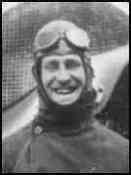 Edward
Ralph Kenneson was born 4 November 1894 in Somerville, Massachussetts.
He learned to fly at the School of Aeronautics at Newport News, Va.
October 1916 and earned his license there on 2 December 1916. Shortly
thereafter, he enlisted in the regular Army and was assigned to Fort
Monroe on 18 Dec 1916.
Edward
Ralph Kenneson was born 4 November 1894 in Somerville, Massachussetts.
He learned to fly at the School of Aeronautics at Newport News, Va.
October 1916 and earned his license there on 2 December 1916. Shortly
thereafter, he enlisted in the regular Army and was assigned to Fort
Monroe on 18 Dec 1916.
He was detailed to Princeton as the
chief instructor in April 1917. Kenneson oversaw much of the original
organization of the Corps at Princeton including the construction of the
hangers, and surrounding buildings and the construction of the four newly
arrived JN-4B’s.
Kenneson gave most of the cadets their
first ride. His fiance lived in Hamilton Square, NJ, just a short flying
distance from the field. Carl Erdman, who was one of Kenneson’s students
recalled that Kennson would fly over his fiances home and loop the Jenny.
According to Erdman, there were no fatal results except Kennesons "marriage
to the occupant".
When Princeton
was disbanded in August, he was sent to Kelly field.
On 22 August 1917 he sailed for France
as CO 36th Aero Squadron. He continued instructing at the 3rd Aviation
Instruction Center at Issodun, France "for over a year" before applying
for assignment to a front line squadron. On 12 July 1918, he was assigned
to the 91st Aero Squadron, a Corps observation unit. Kenneson
did excellant work with the 91st and was transferred to the 9th Aero Squadron
on 2 September 1918. By the end of September, Kenneson was appointed
Commanding Officer of the 9th and served in that capacity until the end
of the war. Known as a tireless pilot, he continued flying missions with
the 9th after taking over the unit. According to one pilot in the 9th,
Kenneson had more hours than any other pilot in the unit. Kenneson was
recommended for a a Captaincy, but before his promotion could come through,
he died of pneumonia on 9 January 1919 while with the Army of Occupation.
He was buried at Suresnes, France.
Photo: Lt. Edward
Ralph Kenneson. Photo from Seely G. Mudd Archives, Princeton University.
This photo
and brief biographical sketch have been generously supplied by Mike O’Neal.
Mike has been compiling a complete history of the Princeton group since
around 1980. Over the last few years, he has interviewed many of the families
and writes that he is glad he waited just a bit longer to start writing
the "final" product. If you have more information or photos of this pioneer
aviator, we would love to hear from you.
|
B. KIPKE
[éd.], «Edward Norval Fortson», in ID. [éd.], «The
Society of the Sons of the Revolution in the District of Columbia:
Honor Honor Roll of the members of the Sons of the Revolution in the
District of Columbia who in the spirit of self sacrifice enrolled
themselves in the service of their Country in the World War of 1914-1918
(1920)», in ID., Kipke Genealogy, http://freepages.genealogy.rootsweb.com/~kipke/sotr/honroll2.htm,
1998 (en ligne en 2004).
Edward Norval
FORTSON: Enlisted in Signal Reserve Corps, Air Service, U. S. Army,
July 18, 1917; Commissioned Second Lieutenant, May 18, 1918; First Lieutenant,
May 18, 1918. School of Military Aeronautics, Princeton University,
Princeton, N.J.; Italian School of Aviation, Foggia, Italy; Italian
Air Force (Breveted "Pilote Aviatori" in Italian Army); Adjutant,
102d Aero Squadron; 36th Aero Squadron; Post Adjutant, Cazaux,
France; Officer in charge of enlisted division at Tours, France. Honorably
discharged June 27, 1919.
|
Alice ALLEN & Holly VONDEROHE
[éd.], «The Camas Post, November 16, 1917» [extrait
d’un journal local du Comté de Clarck dans l’état Washington,
USA], in ID., «THIS WEEK IN CLARK COUNTY», in USGenWeb
Project [United States Genealogy Network,
Inc.],
http://www.rootsweb.com/~waclark/ccwweek2.html,
1999 (en ligne en 2004).
The Camas Post,
November 16, 1917:
Personals:
A letter received
recently at the W. W. PHILBRICK home, from their son, Lewis, says that
the latter is now with the 36th aero squadron in France. Further statement
is made that the Camas company of boys in the aero service has been broken
up and assigned to various stations. PHILBRICK and Clyde BETTS are yet together
in the 36th to which they were recently transferred from the 30th squadron.
|
37th
Aero Squadron
Sur le 37e escadron
AFHRA
[Air Force Historical Research Agency (Maxwell AFB, Alabama)], «37th
Bomb Squadron» [37th Aero Squadron], in ID., Research Division.
Organizational History Branch, http://www.maxwell.af.mil/au/afhra/wwwroot/rso/squadrons_flights_pages/0037bs.html, 2001 (en ligne en 2004).
| 37th Bomb Squadron. — Lineage:
Organized as 37th Aero Squadron on 13 Jun 1917. Demobilized on 15 Apr 1919.
[…]. — Assignments: Unkn, 13 Jun–Sep 1917; Third Aviation Instruction Center,
Sep 1917–Jan 1919; unkn, Jan–15 Apr 1919. […]. — Stations: Camp Kelly, TX,
13 Jun–11 Aug 1917; Etampes, France, 18 Sep 1917; Issoudun, France, 23 Sep
1917; Bordeaux, France, c. 6 Jan–c. 18 Mar 1919; Mitchel Field, NY, c. 5–15
Apr 1919. […]. — Operations : Construction, 1917–1918; flying training, 1918.
[…] Honors: Service Streamers. World War I Theater of Operations.
|
TIGER-LAIR.ORG,
«USAF 037BS», in TigerLair.org, http://www.tiger-lair.org/The.Lair/WW.Tigers/wwt.n-america/USAF_037BS/,
en ligne en 2004.
History: The 37th Bomb Squadron
was activated for the first time on 13 June 1917 at Camp Kelly, TX
as the 37th Aero Squadron. Equipped with the Avro 504-K. After a period
of 14 years of being disbanded (from 1919 to 1933) the 37th reformed at
Langley Field, VA as the 37th Pursuit Squadron flying the Curtis P-6
’Hawk’.
|
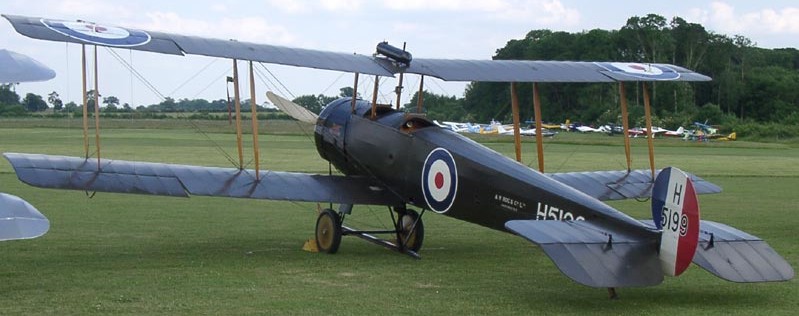
Avro 504-K, appareil utilisé par le 37th Aero Squadron
en 1917.
Sur 4 membres
du 37e escadron
(Matthew
Meehan, John L. Pierson, Josse C. West, Albert E. Halfpenny)
ROOTWEB.COM, «Jersey City World War
I Roll of Honor», in ID., «Hudson County, New Jersey: Jersey
City», in RootWeb.Com, http://www.rootsweb.com/~njhudson/JC/wwim-q.htm, en
ligne en 2004.
MEEHAN, Matthew
|
37th Aero Squadron, U.S. Army
|
France
|
94 Hudson Street
|
No Entry
|
|
INTERMENT.NET,
«San
Francisco National Cemetery (San Francisco, San Francisco County, California). Surnames Pen-Pig» [page des patronymes
de Pen- à Pig-], in ID., Cemetery Transcription Library
[Browse 3,709,236 cemetery records across 7,882 cemeteries from around
the world] http://ww.interment.net/data/us/ca/sanfran/ sfnat/san_fran_penpig.htm, en ligne en 2004.
Pierson, John L, d. 03/28/1928,
PVT 37TH AERO SQDN, Plot: B 65, * [* Records with an asterisk at the
end indicates those that have not been verified as accurate by the U.S. Department
of Veterans’ Affairs].
|
INTERMENT.NET,
«Willamette
National Cemetery (Portland, Multnomah County, Oregon). Surnames W» [page des patronymes en W-],
in ID., Cemetery Transcription Library
[Browse 3,709,236 cemetery records across 7,882 cemeteries from around
the world] http://www.interment.net/data/us/or/multnomah/ willanat/w/willamette_w07.htm, en ligne en 2004.
West, Josse C, b. 09/20/1886,
d. 12/18/1956, CHAUFFEUR 1ST CL 37TH AERO SQ AIR SVC, Plot: K’ 1957,
bur. 12/21/1956, * [* Records with an asterisk at the
end indicates those that have not been verified as accurate by the U.S. Department
of Veterans’ Affairs].
|
INTERMENT.NET, «Golden Gate National Cemetery (San Bruno, San Mateo County, California). Surnames H» [page des patronymes en H-],
in ID., Cemetery Transcription Library
[browse 3,709,236 cemetery records across 7,882 cemeteries from around
the world] http://www.interment.net/data/us/ca/sanmateo/ ggate/h/golden_h01.htm, en ligne en 2004.
Halfpenny, Albert E, d. 06/09/1942,
PVT 1/CL 37TH AERO SQDN, AV SECT SIGNAL CORPS, Plot: L BLO7670, bur.
06/25/1942, *
[*
Records with an asterisk at the end indicates those that have not been verified
as accurate by the U.S. Department of Veterans’ Affairs].
|
Notre photographie de haut de page a été
partiellement reproduite par un magazine étatsunien, Kids dicover,
dans un numéro consacré à Teddy Roosevel: Kids Discover
XV/9 (septembre 2005), p. 16, avec mention du crédit photographique
p. 20.
Merci de nous communiquer toute autre données.
Any other data welcome.
|

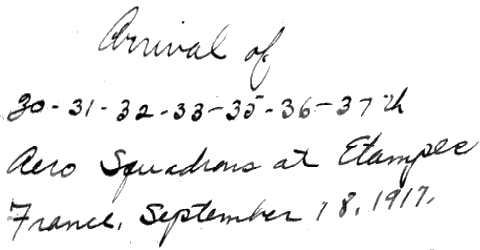
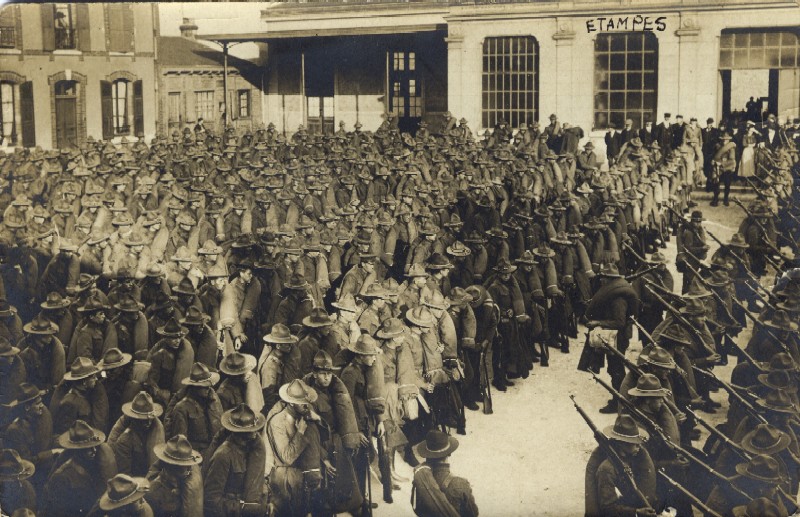



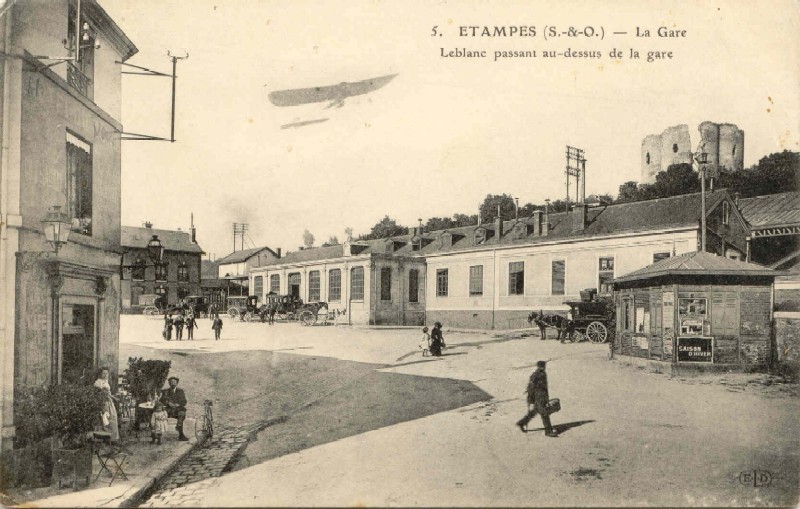
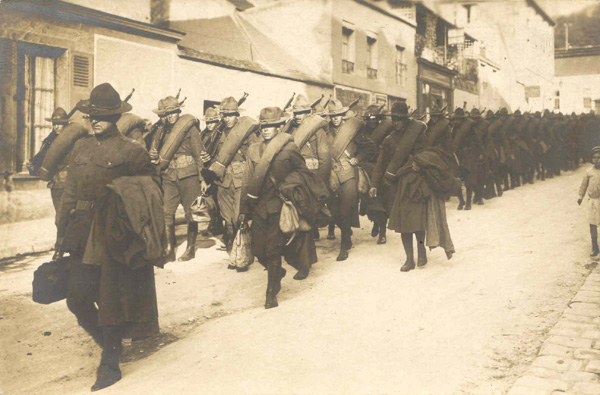
 Cette page est consacrée
et dédiée aux jeunes Étatsuniens qui traversèrent
l’océan durant l’été 1917 pour venir combattre
aux côtés de la France les Empire centraux. Sept escadrons
aériens firent alors une escale de cinq jours à Étampes,
sur la route d’Issoudun. Nous avons acheté à un vendeur
étatsunien, parmi un lot de photographies anciennes, une carte-photo
Rameau fort rare commémorant leur arrivée. Nous y avons
joint ce que l’Abeille d’Étampes rapporte de cet événement,
et tout ce que nous avons pu glaner sur la Toile au sujet de ces braves
garçons. On y apprend notamment comment les hommes du Lieutenant
Roosevelt, fils du président des États-Unis, se jouèrent
malicieusement de leurs hôtes et firent le tour de chacun des 74
bistrots de notre bonne ville d’Étampes. Cette page a été mise à jour en mai 2005,
grâce aux contributions de Denis Decroix et de Didier Lecoq dont les
remercions chaleureusement ici.
Cette page est consacrée
et dédiée aux jeunes Étatsuniens qui traversèrent
l’océan durant l’été 1917 pour venir combattre
aux côtés de la France les Empire centraux. Sept escadrons
aériens firent alors une escale de cinq jours à Étampes,
sur la route d’Issoudun. Nous avons acheté à un vendeur
étatsunien, parmi un lot de photographies anciennes, une carte-photo
Rameau fort rare commémorant leur arrivée. Nous y avons
joint ce que l’Abeille d’Étampes rapporte de cet événement,
et tout ce que nous avons pu glaner sur la Toile au sujet de ces braves
garçons. On y apprend notamment comment les hommes du Lieutenant
Roosevelt, fils du président des États-Unis, se jouèrent
malicieusement de leurs hôtes et firent le tour de chacun des 74
bistrots de notre bonne ville d’Étampes. Cette page a été mise à jour en mai 2005,
grâce aux contributions de Denis Decroix et de Didier Lecoq dont les
remercions chaleureusement ici. Nous connaissons
les noms de plusieurs de ces soldats et de leurs officiers. Le 31e était
commandé par le capitaine Spatz, qui s’illustra plus tard comme
général lors du débarquement allié de 1944
(sous le nom modifié de Spaatz). Le 32e était commandé
par le First Lieutenant J. Dickinson Este, le 33e par le First Lieutenant Robert Haverty et le 36e par le First Lieutenant
Quentin Roosevelt, fils du Président des Etats-Unis Theodore Roosevelt.
Ce charmant jeune homme connu pour son humour fut abattu en plein vol à
l’âge de vingt ans derrière les lignes ennemis le 14 juillet
1918 à Chamery près de Reims, et il repose désormais
au cimetière militaire américain de Colville-sur-Mer à
Omaha Beach, aux côtés de son frère Ted, mort en Normandie
peu après le débarquement de 1944.
Nous connaissons
les noms de plusieurs de ces soldats et de leurs officiers. Le 31e était
commandé par le capitaine Spatz, qui s’illustra plus tard comme
général lors du débarquement allié de 1944
(sous le nom modifié de Spaatz). Le 32e était commandé
par le First Lieutenant J. Dickinson Este, le 33e par le First Lieutenant Robert Haverty et le 36e par le First Lieutenant
Quentin Roosevelt, fils du Président des Etats-Unis Theodore Roosevelt.
Ce charmant jeune homme connu pour son humour fut abattu en plein vol à
l’âge de vingt ans derrière les lignes ennemis le 14 juillet
1918 à Chamery près de Reims, et il repose désormais
au cimetière militaire américain de Colville-sur-Mer à
Omaha Beach, aux côtés de son frère Ted, mort en Normandie
peu après le débarquement de 1944.